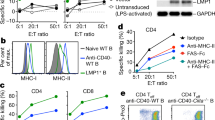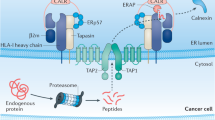Abstract
A major class of tumors lack expression of the transporters associated with antigen processing (TAP). These proteins are essential for delivery of antigenic peptides into the lumen of the endoplasmic reticulum (ER) and subsequent assembly with nascent major histocompatibility complex (MHC) class I, which results in cell surface presentation of the trimeric complex to cytolytic T lymphocytes. Cytolytic T lymphocytes are major effector cells in immunosurveillance against tumors. Here we have tested the hypothesis that TAP downregulation in tumors allows immunosubversion of this effector mechanism, by establishing a model system to examine the role of TAP in vivo in restoring antigen presentation, immune recognition, and effects on malignancy of the TAP-deficient small-cell lung carcinoma, CMT.64. To test the potential of providing exogenous TAP in cancer therapies, we constructed a vaccinia virus (VV) containing the TAP1 gene and examined whether VV-TAP1 could reduce tumors in mice. The results demonstrate that TAP should be considered for inclusion in cancer therapies, as it is likely to provide a general method for increasing immune responses against tumors regardless of the antigenic complement of the tumor or the MHC haplotypes of the host.
This is a preview of subscription content, access via your institution
Access options
Subscribe to this journal
Receive 12 print issues and online access
$259.00 per year
only $21.58 per issue
Buy this article
- Purchase on SpringerLink
- Instant access to full article PDF
Prices may be subject to local taxes which are calculated during checkout





Similar content being viewed by others
References
Tanaka, K., Isselbacher, K.J., Khoury, G. & Jay, G. Reversal of oncogenesis by the expression of a major histocompatibility complex class I gene. Science 228, 26 (1985).
Wallid, R. et al. Abrogation of metastatic properties of tumour cells by de novo expression of H-2K antigen following H-2 gene transfection. Nature 315, 301–305 (1985).
Seliger, B., Maeurer, M.J. & Ferrone, S. TAP off–Tumors on. Immunol. Today 18, 292 (1997).
Garrido, F. et al. Implications for immunosurveillance of altered HLA class I phenotypes in human tumours. Immunol. Today 18, 89 (1997).
Hammerling, G.J., Klar, D., Pulm, W., Momburg, F. & Moldenhauer, G. The influence of major histocompatibility complex class I on tumor growth and metastasis. Biochim. Biophys. Acta 907, 245 (1987).
Singal, D.P., Ye, M. & Qiu, X. Molecular basis for lack of expression of HLA class I antigen in human small-cell lung carcinoma cell lines. Int. J. Cancer 68, 629 (1996).
Braciale, T.J. & Braciale, V.L. Viral antigen presentation and MHC assembly. [Review]. Semin. Immunol. 4, 81–84 (1992).
Rammensee, H.G. Antigen presentation—recent developments [Review]. Int. Arch. Allergy Immunol. 110, 299–307 (1996).
Momburg, F., Roelse, J., Neefjes, J. & Hammerling, G.J. Peptide transporters and antigen processing [Review]. Behring Inst. Mitteilungen (1994).
Neefjes, J.J., Schumacher, T.N. & Ploegh, H.L. Assembly and intracellular transport of major histocompatibility complex molecules [Review]. Curr. Opin. Cell Biol. 3, 601–609 (1991).
Cromme, F.V. et al. Loss of transporter protein, encoded by the TAP-1 gene, is highly correlated with loss of HLA expression in cervical carcinomas. J. Exp. Med. 179, 335–340 (1994).
Maeurer, M.J. et al. Tumour escape from immune recognition: lethal recurrent melanoma in a patient associated with downregulation of the peptide transporter protein TAP-1 and loss of expression of the immunodominant MART-1/Melan-A antigen. J. Clin. Invest. 98, 1633 ( 1996).
Seliger, B. et al. Expression and function of the peptide transporters in escape variants of human renal cell carcinomas. Exp. Hematol. 25, 608 (1997).
Wang, R.F. & Rosenberg, S.A. Human tumor antigens recognized by T lymphocytes: implications for cancer therapy. J. Leuk. Biol. 60, 296–309 ( 1996).
Franks, L.M., Carbonell, A.W., Hemmings, V.J. & Riddle, P.N. Metastasizing tumors from serum-supplemented and serum-free cell lines from a C57B1 mouse lung tumour. Cancer Res. 36, 1049 (1976).
Klar, D. & Hammerling, G.J. Induction of assembly of MHC class I heavy chains with β2-microglobulin by interferon-gamma. EMBO J. 8, 475 (1989 ).
Jefferies, W.A., Kolaitis, G. & Gabathuler, R. IFN-induced recognition of the antigen-processing variant CMT.64 by cytolytic T cells can be replaced by sequential addition of β2-microglobulin and antigenic peptides. J. Immunol. 151, 2974–2985 (1993).
Gabathuler, R., Reid, G., Kolaitis, G., Driscoll, J. & Jefferies, W.A. Comparison of cell lines deficient in antigen presentation reveals a functional role for TAP-1 alone in antigen processing. J. Exp. Med. 180, 1415–1425 (1994).
Reid, G.S.D. Functional relevance and structural requirements of peptide transport in a murine carcinoma cell line (PhD Thesis). (Biotechnology Laboratory, Univ. of British Columbia, Vancouver, BC, Canada; 1997).
Vose, B.M. & Moose, M. Human tumor-infiltrating lymphocytes: a marker of host response. Semin. Haematol. 22, 27–40 (1985).
Inglis, J.R. T Lymphocyte today. (Elsevier Science Publisher, Amsterdam, The Netherlands; 1983).
Mackett, M. & Smith, G.L. Vaccinia virus expression vectors. J. Gen. Virol. 67, 2067– 2082 (1986).
SAS Institute, Inc. JMP IN version 3.2.1. (Duxbury Press, Pacific Grove, CA; 1989–1997).
Acknowledgements
We would like to thank Bernard Moss, John Yewdell, Sun Kvist, and Geoff Butcher for their generosity in providing reagents for this work. We would also like to thank the Jefferies lab for support and for reviewing the manuscript. Finally we acknowledge support from the MRC of Canada and the National Cancer Institute of Canada.
Author information
Authors and Affiliations
Corresponding author
Rights and permissions
About this article
Cite this article
Alimonti, J., Zhang, QJ., Gabathuler, R. et al. TAP expression provides a general method for improving the recognition of malignant cells in vivo. Nat Biotechnol 18, 515–520 (2000). https://doi.org/10.1038/75373
Received:
Accepted:
Issue date:
DOI: https://doi.org/10.1038/75373
This article is cited by
-
A diversity of novel type-2 innate lymphoid cell subpopulations revealed during tumour expansion
Communications Biology (2024)
-
The mutational profile of immune surveillance genes in diagnostic and refractory/relapsed DLBCLs
BMC Cancer (2021)
-
MHC class I dysfunction of glioma stem cells escapes from CTL-mediated immune response via activation of Wnt/β-catenin signaling pathway
Oncogene (2020)
-
Discovery of a Metastatic Immune Escape Mechanism Initiated by the Loss of Expression of the Tumour Biomarker Interleukin-33
Scientific Reports (2016)
-
HMME-based PDT restores expression and function of transporter associated with antigen processing 1 (TAP1) and surface presentation of MHC class I antigen in human glioma
Journal of Neuro-Oncology (2011)



